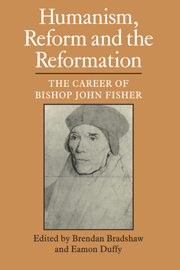Book contents
- Frontmatter
- Contents
- Preface
- List of abbreviations
- Bishop John Fisher, 1469–1535: the man and his work
- John Fisher and the promotion of learning
- The University chancellor
- The bishop in his diocese
- Fisher and Erasmus
- Fisher and More: a note
- The polemical theologian
- Fisher's view of the Church
- Fisher, Henry VIII and the Reformation crisis
- Royal ecclesiastical supremacy
- The spirituality of John Fisher
- Appendixes
- Index
The bishop in his diocese
Published online by Cambridge University Press: 04 August 2010
- Frontmatter
- Contents
- Preface
- List of abbreviations
- Bishop John Fisher, 1469–1535: the man and his work
- John Fisher and the promotion of learning
- The University chancellor
- The bishop in his diocese
- Fisher and Erasmus
- Fisher and More: a note
- The polemical theologian
- Fisher's view of the Church
- Fisher, Henry VIII and the Reformation crisis
- Royal ecclesiastical supremacy
- The spirituality of John Fisher
- Appendixes
- Index
Summary
The study of John Fisher's episcopate is of unusual interest. Its length alone was remarkable enough by medieval standards, being exceeded at Rochester by only one bishop, Hamo de Hethe (1319-52). More important still, Fisher was one of the few of any generation to be hailed in his own lifetime as a model bishop. The great humanist scholar Desiderius Erasmus commented in a letter to his friend Reuchlin in 1520, ‘Episcopus ille anglus, quo non alius in ea gente vel eruditor vir, vel praesul sanction’ Erasmus was not alone in his opinion. In 1537 Reginald Pole, admittedly partisan, wrote to Henry VIII in his De Unitate Ecclesiae,
What other have you, or have you had for centuries, to compare with Rochester in holiness, in learning, in prudence and in episcopal zeal? You may be, indeed, proud of him, for, were you to search through all the nations of Christendom in our days, you would not easily find one who was such a model of episcopal virtues.
Seventy years later Cardinal Borromeo was to keep a portrait of Fisher in his study and venerate it equally with that of St Ambrose, founder of his diocese of Milan. In addition to this praise, we are fortunate enough to have detailed descriptions of him and appraisals of his life written by contemporaries and by one who had access to people who knew him.
- Type
- Chapter
- Information
- Humanism, Reform and the ReformationThe Career of Bishop John Fisher, pp. 67 - 80Publisher: Cambridge University PressPrint publication year: 1989



